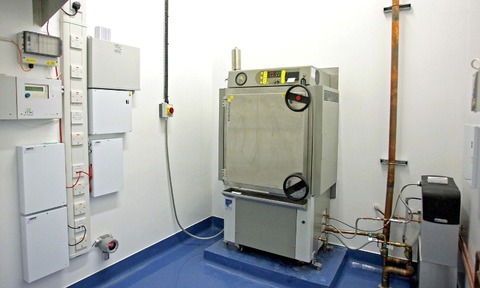
Brunel University has benefited from the introduction of a 350l double-door autoclave from Priorclave.
The double-door autoclave was supplied and installed within the Heinz Wolf building, a Centre for Infection, Immunity and Disease Mechanisms, and a School of Health Sciences with a CAT II and CAT III Research Facility for secure decontamination of hazardous waste.
Pass-through or Double Entry autoclaves are used in relatively small numbers and require often complicated, building work as part of the installation process.
For this reason double entry units are considered bespoke, to satisfy specific application requirements, raising additional points for consideration such as – clean room or containment, direction of workflow, door swing profile and thermocouple entry ports.
At Brunel University it was impossible to do a full site survey as the would-be laboratory was a building site with no walls, nevertheless, the Priorclave representative was able to walk the route from entry into the building to the laboratory.
The route required the use of a goods lift and passing through single doorways as narrow as 900mm, then through another laboratory whose entrance lay between a sink and a bench.
Performance and build
Priorclave designed and built the autoclave to the specifications requested by CDC and the end users at Brunel University, supplying a 350l double-ended autoclave with electrical heating, vacuum facility, a printer and an exhaust filtration system for the containment of any hazardous pathogens.
According to Priorclave, the design gave Brunel University a more cost-effective solution.
The benefit of a electrically heated machine over one with a steam generator is that it uses less power, only switched on when in use. Also it would streamline the installation of the trough-wall machine since all elements are contained within the actual autoclave design.
It was imperative that the double-door design had both ends of the autoclave isolated, sealed at the point of passing through the wall by means of a bulkhead, interlocks preventing both doors being open at the same time as this would obviously breach the integrity of the site.
An interlock prevents the door at the unloading end from being opened until the sterilisation cycle has been successfully completed and the load is safe to pass into the unloading end.
It is also standard with Priorclave machines that it is not possible to release the loading door until the unloading door has been opened and subsequently closed and locked.
As Brunel’s autoclave was a containment suite autoclave, most of it was located within the unloading room with just the door section of the autoclave protruding into the containment area.
This allows the majority of the maintenance tasks to be completed without the need for an engineer to enter the containment area or for the area to be decontaminated and temporarily disabled.
It is normally desirable for the operator unloading the autoclave to be able to examine the record before opening the autoclave.
For this reason and the fact that it is often not permissible to remove a paper record from a containment area, the printer was put on the non-containment end of the autoclave.
Following installation Priorclave engineers returned to Brunel University to test the autoclave with the actual loads and made adjustments to the autoclave and software to ensure optimum performance.






